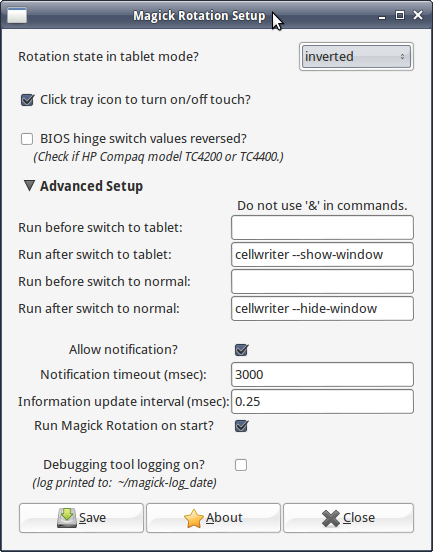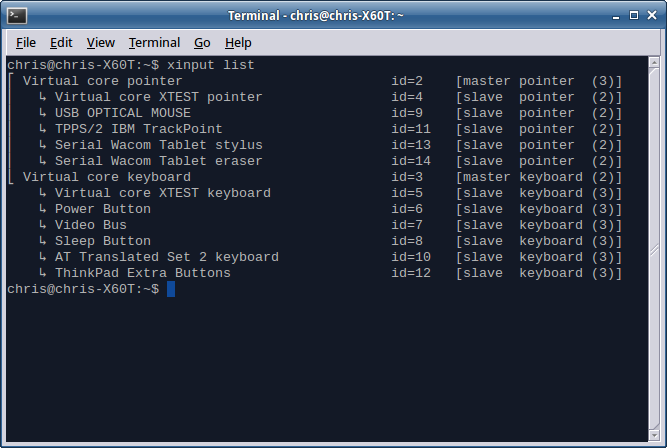In this guide you will find how to set up screen rotation on ThinkPad tablet/laptops on a Linux distribution. This is a two part guide; first, we will get auto-rotation working and second, we will bind a 90* counter-clock-wise rotation to a key (usually the rotate key on the face of the tablet).
Part One: Automatic Rotation
A very nice quality-of-life feature of ThinkPad tablets is the automatic screen rotation. When the screen is rotated and folded down, the laptop knows to change the screen orientation... or at least, it should. Now the script below works for Lenovo/IBM, HP, Fujitsu, and Dell tablet hybrids. Below is the link to the LaunchPad webpage for the program:
Magick Rotation
This is a fairly easy to use program, as it has an installer after you extract the .tar.bz file that works on Ubuntu, Fedora, both versions of Linux Mint, and openSUSE. Because it works on Ubuntu, I will venture to say it will run on all (semi) official variants, which are Lubuntu, Xubuntu, Ubuntu Studio, and Kubuntu. However, I only use Xubuntu so I can only confirm it does indeed work on that particular variant. As a note, inside of the .tar.bz, is a file with manual installation instructions, which presumably help you install it on other Linux distributions such as Bodhi Linux.
Here is what the program looks like after it is installed;

As you can see, it is very simple. By default, the rotation state is set to right, but I have mine set to inverted. Also by default, Magick Rotation is told to start on computer start. Finally, by default (underneath Advanced Settings) is the command to show CellWriter when the tablet is rotated and hide when it is unrotated. CellWriter is one on screen keyboard that is available through the Ubuntu Software Center. In my limited use, it works pretty well so far. Obviously you can leave these lines but if you don't have CellWriter installed, you computer may pop a notification of calling a program that doesn't exist. Personally, I like it better than OnBoard that comes default on Xubuntu. Plus, the commands already there, so it's easy.
So that was the easy part, now for something that can prove a bit trickier...
Part Two: 90* CCW Rotation Script
So this simple script is a script that, when used, rotates the screen 90* Counter-Clock-Wise (if ran without swinging the screen) and changes your inputs to act accordingly. So let's get started...
Please Note: Credit for this goes to the Wacom Linux guys over at SourceForge, found here;
Wacom Linux Pages
Step One: Get Input Names
This first step is very important, because without using your models specific names of the TouchPad, Stylus, and TrackPoint, it WILL NOT FUNCTION. So first thing is to open a terminal and run the following command (If you use any external inputs, such as a Wacom Tablet or Mouse, PLUG THEM IN NOW!):
Code: Select all
xinput list
Step Two: Make the Script
Now, keep that open and make a new empty file (Right Click > New Document > Empty File) and copy this script into it (again, thank the Wacom Linux guys!);
Code: Select all
#!/bin/sh
# Find the line in "xrandr -q --verbose" output that contains current screen orientation and "strip" out current orientation.
rotation="$(xrandr -q --verbose | grep 'connected' | egrep -o '\) (normal|left|inverted|right) \(' | egrep -o '(normal|left|inverted|right)')"
# Using current screen orientation proceed to rotate screen and input devices.
case "$rotation" in
normal)
# rotate to the left
xrandr -o left
xsetwacom set stylus rotate ccw
xsetwacom set eraser rotate ccw
xsetwacom set touch rotate ccw
;;
left)
# rotate to inverted
xrandr -o inverted
xsetwacom set stylus rotate half
xsetwacom set eraser rotate half
xsetwacom set touch rotate half
;;
inverted)
# rotate to the right
xrandr -o right
xsetwacom set stylus rotate cw
xsetwacom set eraser rotate cw
xsetwacom set touch rotate cw
;;
right)
# rotate to normal
xrandr -o normal
xsetwacom set stylus rotate none
xsetwacom set eraser rotate none
xsetwacom set touch rotate none
;;
esacCode: Select all
#!/bin/sh
# Find the line in "xrandr -q --verbose" output that contains current screen orientation and "strip" out current orientation.
rotation="$(xrandr -q --verbose | grep 'connected' | egrep -o '\) (normal|left|inverted|right) \(' | egrep -o '(normal|left|inverted|right)')"
# Using current screen orientation proceed to rotate screen and input devices.
case "$rotation" in
normal)
# rotate to the left
xrandr -o left
xsetwacom set Wacom Tablet stylus rotate ccw
xsetwacom set Wacom Tablet eraser rotate ccw
xsetwacom set TPPS/2 IBM TrackPoint rotate ccw
xsetwacom set USB OPTICAL MOUSE rotate ccw
;;
left)
# rotate to inverted
xrandr -o inverted
xsetwacom set Wacom Tablet stylus rotate half
xsetwacom set Wacom Tablet eraser rotate half
xsetwacom set TPPS/2 IBM TrackPoint rotate half
xsetwacom set USB OPTICAL MOUSE rotate half
;;
inverted)
# rotate to the right
xrandr -o right
xsetwacom set Wacom Tablet stylus rotate cw
xsetwacom set Wacom Tablet eraser rotate cw
xsetwacom set TPPS/2 IBM TrackPoint rotate cw
xsetwacom set USB OPTICAL MOUSE rotate cw
;;
right)
# rotate to normal
xrandr -o normal
xsetwacom set Wacom Tablet stylus rotate none
xsetwacom set Wacom Tablet eraser rotate none
xsetwacom set TPPS/2 IBM TrackPoint rotate none
xsetwacom set USB OPTICAL MOUSE rotate none
;;
esacStep Three: Save and Change Permissions of the Script
Now, save this script to somewhere you can find and access it with sudo (preferably, I haven't tested it in a root location). I put mine in ~/usr/share/ and named it rotate. You do not need to append a file type to the end (i.e no .sh) Open a terminal at this location (either Right Click > Open Terminal Here or open a terminal and use the 'cd' command to get there) and run this command to make it executable;
Code: Select all
sudo chmod +xStep Four: Bind the Script
Now to make your keyboard shortcut. Again, this is distribution specific, and may be accomplished with a bit more work from the terminal, but Xubuntu includes a GUI for this. Below is a quick guide for Xubuntu Users, which may help other distributions;
First, go to Settings Manager and find Keyboard

Next, click on the tab that says Application Shortcuts and click Add

Finally, use the little Open button to find your script file.

And then it will ask for a command. Merely press the button you wish to register to the script (In my case, I pushed the button on my screen bezel). All done!
Thanks for reading guys! Please comment with any suggestions or if you would like another guide to setting up something in Xubuntu or Linux in general!stripstrip



